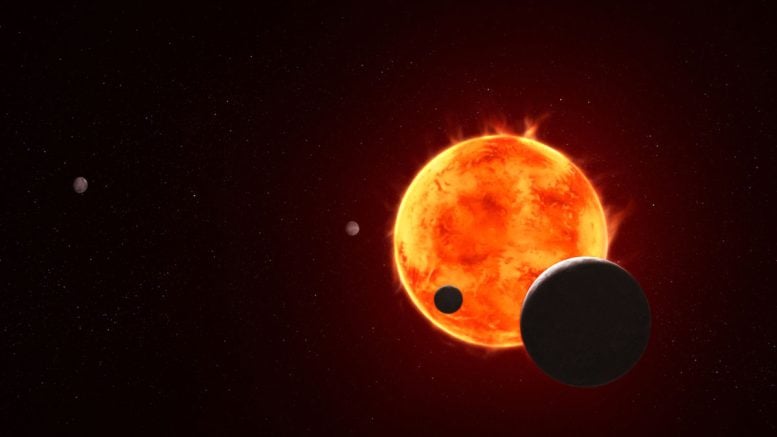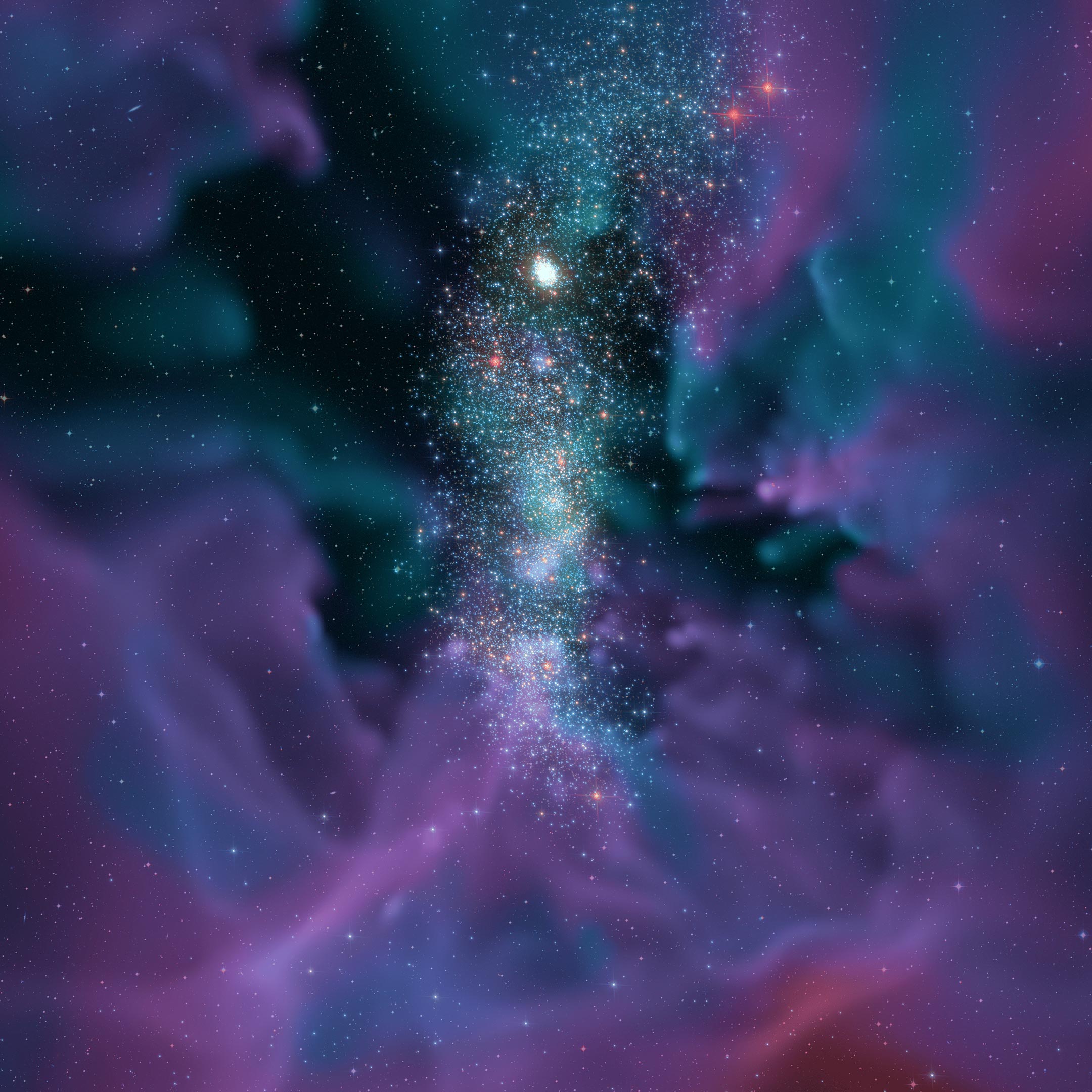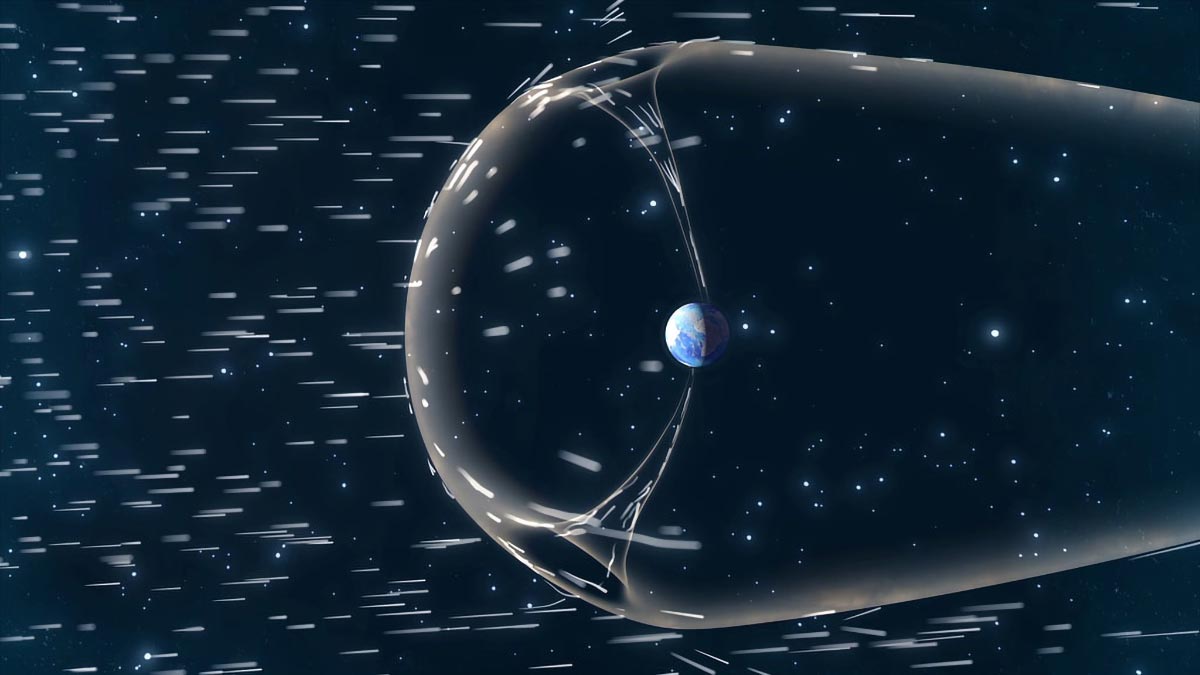PROTECT YOUR DNA WITH QUANTUM TECHNOLOGY
Orgo-Life the new way to the future Advertising by Adpathway The Earth-size exoplanet TRAPPIST-1 e, depicted at the lower right, is silhouetted as it passes in front of its flaring host star in this artist’s concept of the TRAPPIST-1 system. Credit: NASA, ESA, CSA, J. Olmsted (STScI)
The Earth-size exoplanet TRAPPIST-1 e, depicted at the lower right, is silhouetted as it passes in front of its flaring host star in this artist’s concept of the TRAPPIST-1 system. Credit: NASA, ESA, CSA, J. Olmsted (STScI)TRAPPIST-1e shows no signs of its first atmosphere, but hints of a secondary one remain. Liquid water could still be possible.
Astrophysicists at the University of Bristol are contributing to new insights about an Earth-sized exoplanet located 40 light years away, where liquid water could exist as either a vast ocean or an icy surface layer.
Such conditions would only be possible if the planet retains an atmosphere – a central question researchers are working to answer, now with greater precision using the most powerful space telescope available.
Through NASA’s JWST, scientists have advanced this investigation as part of a large international collaboration studying both the surface and potential atmosphere of TRAPPIST-1e, often referred to simply as planet e, which orbits within the habitable zone of the red dwarf star TRAPPIST-1.
Why planet e is significant
Exoplanets are diverse worlds that orbit stars beyond our solar system. Planet e is especially compelling because, in theory, liquid water could remain stable on its surface if the temperature is neither excessively hot nor cold. This balance, however, depends entirely on the presence of an atmosphere.
To explore this, researchers used JWST’s advanced NIRSpec (Near-Infrared Spectrograph) instrument while planet e transited its star. As starlight filters through any atmosphere present, some wavelengths are absorbed, producing measurable dips in the spectrum captured by JWST. Each transit provides more data, gradually revealing which chemical compounds might exist in the planet’s air.
Initial results, published on September 8, 2025, in two scientific papers in the journal Astrophysical Journal Letters, indicate several potential scenarios, including the possibility of an atmosphere.
Dr. Hannah Wakeford, Associate Professor in Astrophysics at the University of Bristol, is a leading member of the JWST Transiting Exoplanet team who helped design the observational set-up for the telescope to ensure scientists obtain vital data.
Dr. Wakeford said: “What we have found with JWST in these first four observations helps refine the earlier Hubble measurements and reveals there might now be hints of an atmosphere, but we cannot yet rule out the possibility there is nothing to detect.”
“JWST’s infrared instruments are providing unprecedented detail, helping us understand much more about what determines a planet’s atmosphere and surface environment, and what they’re composed of. It’s incredibly exciting to be peeling back the curtain of these fascinating other worlds, measuring the details of starlight around Earth-sized planets to ascertain what it might be like, and if life could be possible. Through a careful process of elimination and comparison, we’re uncovering great new insights.”
Ruling out primordial hydrogen
While several outcomes are still possible for planet e, scientists are certain that it no longer retains the atmosphere it originally formed with.
Co-author of both studies, Dr. David Grant, a former Senior Research Associate at the University of Bristol, explained: “The findings also further rule out the presence of a primordial hydrogen-based atmosphere. This is the gaseous envelope, mainly comprising hydrogen, that surrounded a planet in its early stages of formation. Such atmospheres are believed to be common for both giant planets and terrestrial planets in the early solar system.”
Dr. Wakeford added: “Since TRAPPIST-1 is a very active star, with frequent flares, it’s not surprising that any hydrogen-helium atmosphere the planet may have formed would be stripped off by stellar radiation. Many planets, including Earth, build up a heavier secondary atmosphere after losing their primary atmosphere. It is possible planet e was never able to do this and doesn’t have a secondary atmosphere, but there’s an equal chance one does exist.”
Secondary atmospheres and greenhouse effect
The presence of a secondary atmosphere means liquid water could also exist on the surface and if that’s the case, researchers understand it would be accompanied by a greenhouse effect, akin to that of planet Earth, in which various gases, especially carbon dioxide, keep the atmosphere stable and the planet warm.
The second paper details work on the theoretical interpretation and lead author Dr. Ana Glidden, a post-doctoral researcher at Massachusetts Institute of Technology, explained: “It is unlikely the atmosphere of planet e is dominated by carbon dioxide, like the thick atmosphere of Venus and the thin atmosphere of Mars. But it’s also important to note there are no direct parallels with our solar system. TRAPPIST-1 is a very different star from our Sun, and the planetary system around it is also distinct.”
Dr. Wakeford added: “A little greenhouse effect can go a long way and the new measurements do not rule out sufficient carbon dioxide to sustain some liquid water on the surface. The liquid water could take the form of a global ocean, or cover a smaller area of the planet where the star is at perpetual noon, surrounded by ice. This would be possible because, owing to TRAPPIST-1’s planets’ sizes and close orbits to their star, they are all tidally locked, with one side always facing the star and the other side in perpetual darkness.”
Next steps in observations
Next steps in the research will involve further detailed observations, comparing data from another exoplanet – planet b – orbiting closest to TRAPPIST-1 in order to make more revelations.
One of the principal investigators of the research team focused on TRAPPIST-1e Dr. Néstor Espinoza, an Associate Astronomer and Mission Scientist for Exoplanet Science at the the Space Telescope Science Institute (STScI) in Baltimore, Maryland, said: “Webb’s infrared instruments are giving us more detail than we’ve ever had access to before, and the initial four observations we’ve been able to make of planet e are showing us what we will have to work with when the rest of the information comes in.”
References: “JWST-TST DREAMS: NIRSpec/PRISM Transmission Spectroscopy of the Habitable Zone Planet TRAPPIST-1 e” by Néstor Espinoza, Natalie H. Allen, Ana Glidden, Nikole K. Lewis, Sara Seager, Caleb I. Cañas, David Grant, Amélie Gressier, Shelby Courreges, Kevin B. Stevenson, Sukrit Ranjan, Knicole Colón, Brett M. Morris, Ryan J. MacDonald, Douglas Long, Hannah R. Wakeford, Jeff A. Valenti, Lili Alderson, Natasha E. Batalha, Ryan C. Challener, Jingcheng Huang, Zifan Lin, Dana R. Louie, Elijah Mullens, Daniel Valentine, C. Matt Mountain, Laurent Pueyo, Marshall D. Perrin, Andrea Bellini, Jens Kammerer, Mattia Libralato, Isabel Rebollido, Emily Rickman, Sangmo Tony Sohn and Roeland P. van der Marel, 8 September 2025, The Astrophysical Journal Letters.
DOI: 10.3847/2041-8213/adf42e
“JWST-TST DREAMS: Secondary Atmosphere Constraints for the Habitable Zone Planet TRAPPIST-1 e” by Ana Glidden, Sukrit Ranjan, Sara Seager, Néstor Espinoza, Ryan J. MacDonald, Natalie H. Allen, Caleb I. Cañas, David Grant, Amélie Gressier, Kevin B. Stevenson, Natasha E. Batalha, Nikole K. Lewis, Douglas Long, Hannah R. Wakeford, Lili Alderson, Ryan C. Challener, Knicole Colón, Jingcheng Huang, Zifan Lin, Dana R. Louie, Elijah Mullens, Kristin S. Sotzen, Jeff A. Valenti, Daniel Valentine, Mark Clampin, C. Matt Mountain, Marshall Perrin and Roeland P. van der Marel, 8 September 2025, The Astrophysical Journal Letters.
DOI: 10.3847/2041-8213/adf62e
The project is part of the JWST-TST DREAMS program, led by Dr. Nikole Lewis, Associate Professor of Astronomy at Cornell University in the US city Ithaca, New York. This international project involves more than 30 scientists from the UK, USA, and India, five of whom are members or former members of Dr. Wakeford’s team. It includes the breakthrough detection of Quartz clouds in the atmosphere of a hot exoplanet, as shown in a recent study, led by Dr. Grant and co-authored by Dr. Wakeford.
Never miss a breakthrough: Join the SciTechDaily newsletter.























 English (US) ·
English (US) ·  French (CA) ·
French (CA) ·  French (FR) ·
French (FR) ·